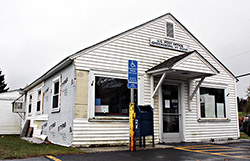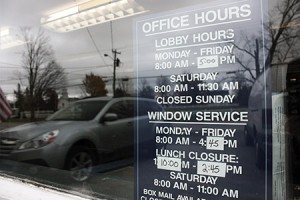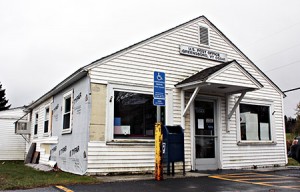

copyright the Chronicle October 29, 2014
by David Dudley
In May of 2012 the United States Postal Service (USPS) implemented the Post Plan, which was devised to curb mounting debt, and prevent thousands of offices, many of them rural post offices, such as those in Greensboro Bend, Craftsbury Common, and Albany, from being shut down altogether. The USPS estimated that the plan would be up and running by September of 2014.
For many rural offices in Orleans County, the Post Plan means decreased window hours, which is affecting local businesses that depend on the Postal Service for shipping. Also, many employees have seen their hours cut, and people who work full-time are having trouble getting to the post office while it’s open.
According to USPS spokeswoman Melissa Lohnes, the Post Plan is a necessary step toward helping the postal service survive ongoing financial challenges and rapidly changing customer behavior.
“The way our customers use mail has changed dramatically,” Ms. Lohnes said via e-mail. “We’re trying to find a balance between regular delivery access, local retail opportunities, expanded access to basic services in alternative venues — such as online, and in village stores, for instance — while preserving rural offices.”
But U.S. Senator Bernie Sanders, an outspoken critic of the changes being made, believes that the so called crisis of the USPS is manufactured.
“The main problem with the Postal Service, as I see it,” Mr. Sanders said in a phone interview “is the legislation passed by the Bush administration in 2006, which required the Postal Service to pre-fund 75 years’ worth of future retiree health benefits in a ten-year period. It amounts to $5-billion a year, and it accounts for 100 percent of the Postal Service’s losses since it was mandated.”
Without that mandate, the USPS would have turned a profit each year since the mandate was passed in 2006, Mr. Sanders said.
That begs the question: Are the changes necessary?
According to the United States Postal Service’s 2013 Annual Report to Congress, the USPS is trying to manage labor costs while improving customer experience.
The cuts may have saved some area post offices from closing, but many community members aren’t pleased with their offices’ limited business hours.
Those offices that have been affected by the Post Plan are no longer open full-time. There are four-hour offices and six-hour offices, depending on the volume of foot traffic.
Max Frohwein of Craftsbury Common struggles with what he calls inconsistency.
“All of the offices out this way have awkward hours,” Mr. Frohwein said. “I live right over there, on the other side of the common. A stone’s throw from the office. But they don’t deliver to me. I’ve got no choice. Still, I guess I’m one of the lucky ones: I don’t have a full-time job.”
Among those who do work hours that conflict with the business hours of their local post offices, Sue Brown of Albany said that she understands the rationale for the cuts. But for her that doesn’t make it any easier to do business with the postal service.
“Where I live, there is no delivery,” Ms. Brown said. “And I work. It’s just becoming inaccessible. I understand the position of the staff — being asked to do more with less — but I have such trouble sending packages now.”
One carrier said that he loves his job, but feels for the customers.
“Many are elderly, and the new schedule just doesn’t sink in,” the carrier said. “We’re under the gun — being asked to do more with less — which is one thing. I don’t mind the challenge. But the customer service is way below par.”
A clerk said that she, too, loves her job. She’s held the position for a number of years but had decided to quit, soon, because she doesn’t like the way things are being done.
And for Katrina Taylor, owner and proprietor of Bien Fait Cakes in Greensboro, the decrease in hours has hurt her business.
“It’s so hard to ship during the busy season,” Ms. Taylor said. “The office is closed for far too long during the middle of the day. And we can have 100 packages going out, and the postal staff has to scan each one. It’s difficult for them, and for the customers waiting in line.
“We have a program that allows us to weigh and print our own labels, but the Postal Service won’t pick up from our bakery,” Ms. Taylor said. “Apparently, they just don’t have the resources.”
Does that mean that the Post Plan is failing? That depends who you ask.
Ms. Taylor has her complaints, but she said the staff at her post office is fabulous. That’s a common sentiment among postal customers in Orleans County.
Lucy LaRose, a retiree who lives in Derby, said that the changes don’t bother her in the least.
“I can visit most any office, any time,” she said. “If they had done this back when I was working, it would have been a big problem. Especially if they were to close down on Saturdays.”
And another USPS employee, a clerk, said that the changes were working beautifully for his office, which was humming with customers.
“Our customers have adapted well,” the clerk said. “There’s been almost no change in volume. And the hours seem to be perfectly suited for what we need to do here.”
While few carriers have been laid off, and there has been little change to their hours, postmasters and clerks at many offices have gone from full-time to part-time employees.
Craftsbury Common, for instance, had a job posting on the community board, announcing an opening for a part-time postmaster. That used to be a career position, where the postmaster acquired a good-paying job, health benefits, and paid vacation. In short, the kind of job one could start a family with. Now it’s a part-time position, the kind of job retirees and students are more likely to seek out.
Is that really the way to control labor costs?
Senator Sanders said it’s imperative to find other ways for the USPS to reduce costs and generate revenue.

“The Postal Service could notarize documents,” he said. “They could issue hunting and fishing licenses. They could ship beer and wine, and they could offer more online services.”
That’s where Ms. Lohnes and Senator Sanders agree. Ms. Lohnes also sees room for growth, where technology based developments may help the Postal Service thrive.
“Nearly 40 percent of postal retail revenue came from usps.com,” Ms. Lohnes said. “And through other approved postal retailers like CVS, Walgreens, Shaw’s, and others.”
According to Ms. Lohnes, the Post Plan has enabled the USPS to decrease work hours by 12 million, or 1.1 percent, in 2013, while increasing delivery destinations to 774,000. So it would appear that it has, indeed, begun on a path to managing labor costs while improving service.
But if the hours are being cut at rural post offices, and the USPS is channeling more work through alternative retailers, what does that mean for the future of its employees?
According to the United States Postal Service’s 2013 Annual Report to Congress, the number of career employees has decreased steadily since 2009 when the USPS reported that it had 623,128 career employees. In 2013, the USPS reported that it had only 491,017 career employees.
During that same period, the postal service increased its number of non-career employees. In 2009, it had 11,477 postmaster relief/leave replacements. In 2013, that number increased to 13,454.
Likewise for a new position, created in 2011, called the postal support employee. In 2011, the USPS employed 10,471 postal support employees. By 2013, that number had dramatically increased to 28,793.
According to Ms. Lohnes, the transitions necessitated by the Post Plan did not include layoffs. Of course, the decrease in hours left some in sticky situations.
“The individual decisions of persons who chose to retire, to remain in their positions, or to seek alternative work positions was a personal one,” Ms. Lohnes said. “We respect that, and did all we could to help people assess what changes suited their situations. We’re working diligently to minimize impact on our employees.”
Senator Sanders finds the trend disturbing, and evidence that there are private interests vying for control of the USPS.
“The Postal Service supports half a million decently paid, union jobs,” Senator Sanders said. “It’s the largest employer of veterans in the country. These are good, middle class jobs. It just doesn’t make sense to cut them without considering other alternatives first.”
The deadline for implementation of the Post Plan has been extended to January 2015. The reason for that, according to Ms. Lohnes, is to allow more time for affected postmasters to make career decisions.
And beginning in 2015, the Craftsbury Village Post Office’s new hours will be: 7:30 a.m. to 10:30 a.m., and then 1 p.m. to 4 p.m. Monday through Friday, and 7:30 a.m. to 10:30 a.m. on Saturday. The hours at other area offices will remain unchanged.
contact David Dudley at [email protected]
For more free articles from the Chronicle like this one, see our Editor’s Picks pages. For all the Chronicle’s stories, subscribe:
Print subscription
Annual online subscription
Short-term online subscription







